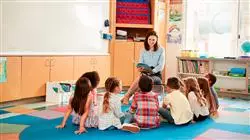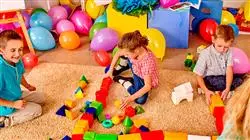University certificate
The world's largest faculty of education”
Introduction to the Program
A high-quality Professional master’s degree that will allow you to work with pre-school students, providing them with all the capabilities for the development of quality teaching”

During the pre-school education stage, students are faced for the first time with numerous challenges that test the teaching capacity of teachers. With a still very incomplete maturation, the students of this school stage need a learning system that takes into account not only the educational aspect at the intellectual level, but also the fundamental emotional areas, the creation of the first personality and socialization, applying for the first time, the rules of social coexistence.
This process is fundamentally conveyed through play and the manipulation of elements and requires the teacher to master the evolutionary psychology of this period and the teaching tools that adapt the learning objectives of the cycle to the capacities and rhythms of the children.
This highly specialized Professional master’s degree will allow students to learn everything they need to specialize in this field of teaching work, including in their expertise the most useful mental and physical tools, based on the latest educational innovation.
An exceptional Professional master’s degree that is distinguished by the fact that it can be taken in a 100% online format, adapting to the needs and commitments of the student, in an asynchronous and completely self-manageable manner.
The student will be able to choose which days, at what time and how much time to dedicate to the study of the contents of the program. Always in tune with the capabilities and skills required for the course.
To this end, the order and distribution of the subjects and their topics is specially designed to allow each student to decide their schedule and self-manage their time. In addition, students will have access to theoretical materials presented with enriched texts, multimedia presentations, exercises and guided practical activities, motivational videos, master classes, and case studies, where they will be able to evoke knowledge in an orderly manner and practice decision-making that demonstrates their learning within the field of teaching.
A higher-level program aimed at those who wish to surround themselves with the best and compete to excel in their profession, not only as a personal objective, but also with the main objective of wanting to make a difference in the education of their students.
A process of professional growth that provides you with the most innovative and interesting teaching tools in pre-school education”
This Professional master’s degree inPre-School Education Didactics contains the most complete and up-to-date educational program on the market. The most important features include:
- The development of practical cases presented in simulated scenarios by experts in the area of knowledge, where the student will demonstrate the knowledge they have learned and demonstrate the acquisition of competencies
- The graphic, schematic, and practical contents with which they are created, provide scientific and practical information on the disciplines that are essential for professional development
- The latest news on the educational task of the pre-school teacher
- Practical exercises where self-assessment is carried out to improve learning, as well as activities at different levels of competence
- Special emphasis on innovative methodologies in educational research
- Theoretical lessons, questions to the expert, debate forums on controversial topics, and individual reflection assignments
- Content that is accessible from any fixed or portable device with an Internet connection
Grow in your teaching capacity by creating a high-quality school experience for the youngest students, boosting their development”
The teaching staff includes professionals from the field who contribute their experience to this program, as well as renowned specialists from leading societies and prestigious universities.
The multimedia content, developed with the latest educational technology, will provide the professional with situated and contextual learning, i.e., a simulated environment that will provide immersive learning programmed to learn in real situations.
This program is designed around Problem-Based Learning, whereby the professional must try to solve the different professional practice situations that arise throughout the program. To this end, the teacher will be assisted by an innovative interactive video system developed by recognized experts in the field of specialization and career guidance with extensive teaching experience.
You will have access to the contents from any fixed or portable device with internet connection, or can download to access at a later moment"

A process of growth in the highest-level skills and competencies that will give your CV a boost to the maximum level of competitiveness"
Why study at TECH?
TECH is the world’s largest online university. With an impressive catalog of more than 14,000 university programs available in 11 languages, it is positioned as a leader in employability, with a 99% job placement rate. In addition, it relies on an enormous faculty of more than 6,000 professors of the highest international renown.

Study at the world's largest online university and guarantee your professional success. The future starts at TECH”
The world’s best online university according to FORBES
The prestigious Forbes magazine, specialized in business and finance, has highlighted TECH as “the world's best online university” This is what they have recently stated in an article in their digital edition in which they echo the success story of this institution, “thanks to the academic offer it provides, the selection of its teaching staff, and an innovative learning method aimed at educating the professionals of the future”
A revolutionary study method, a cutting-edge faculty and a practical focus: the key to TECH's success.
The most complete study plans on the university scene
TECH offers the most complete study plans on the university scene, with syllabuses that cover fundamental concepts and, at the same time, the main scientific advances in their specific scientific areas. In addition, these programs are continuously being updated to guarantee students the academic vanguard and the most in-demand professional skills. In this way, the university's qualifications provide its graduates with a significant advantage to propel their careers to success.
TECH offers the most comprehensive and intensive study plans on the current university scene.
A world-class teaching staff
TECH's teaching staff is made up of more than 6,000 professors with the highest international recognition. Professors, researchers and top executives of multinational companies, including Isaiah Covington, performance coach of the Boston Celtics; Magda Romanska, principal investigator at Harvard MetaLAB; Ignacio Wistumba, chairman of the department of translational molecular pathology at MD Anderson Cancer Center; and D.W. Pine, creative director of TIME magazine, among others.
Internationally renowned experts, specialized in different branches of Health, Technology, Communication and Business, form part of the TECH faculty.
A unique learning method
TECH is the first university to use Relearning in all its programs. It is the best online learning methodology, accredited with international teaching quality certifications, provided by prestigious educational agencies. In addition, this disruptive educational model is complemented with the “Case Method”, thereby setting up a unique online teaching strategy. Innovative teaching resources are also implemented, including detailed videos, infographics and interactive summaries.
TECH combines Relearning and the Case Method in all its university programs to guarantee excellent theoretical and practical learning, studying whenever and wherever you want.
The world's largest online university
TECH is the world’s largest online university. We are the largest educational institution, with the best and widest online educational catalog, one hundred percent online and covering the vast majority of areas of knowledge. We offer a large selection of our own degrees and accredited online undergraduate and postgraduate degrees. In total, more than 14,000 university degrees, in eleven different languages, make us the largest educational largest in the world.
TECH has the world's most extensive catalog of academic and official programs, available in more than 11 languages.
Google Premier Partner
The American technology giant has awarded TECH the Google Google Premier Partner badge. This award, which is only available to 3% of the world's companies, highlights the efficient, flexible and tailored experience that this university provides to students. The recognition as a Google Premier Partner not only accredits the maximum rigor, performance and investment in TECH's digital infrastructures, but also places this university as one of the world's leading technology companies.
Google has positioned TECH in the top 3% of the world's most important technology companies by awarding it its Google Premier Partner badge.
The official online university of the NBA
TECH is the official online university of the NBA. Thanks to our agreement with the biggest league in basketball, we offer our students exclusive university programs, as well as a wide variety of educational resources focused on the business of the league and other areas of the sports industry. Each program is made up of a uniquely designed syllabus and features exceptional guest hosts: professionals with a distinguished sports background who will offer their expertise on the most relevant topics.
TECH has been selected by the NBA, the world's top basketball league, as its official online university.
The top-rated university by its students
Students have positioned TECH as the world's top-rated university on the main review websites, with a highest rating of 4.9 out of 5, obtained from more than 1,000 reviews. These results consolidate TECH as the benchmark university institution at an international level, reflecting the excellence and positive impact of its educational model.” reflecting the excellence and positive impact of its educational model.”
TECH is the world’s top-rated university by its students.
Leaders in employability
TECH has managed to become the leading university in employability. 99% of its students obtain jobs in the academic field they have studied, within one year of completing any of the university's programs. A similar number achieve immediate career enhancement. All this thanks to a study methodology that bases its effectiveness on the acquisition of practical skills, which are absolutely necessary for professional development.
99% of TECH graduates find a job within a year of completing their studies.
Professional Master's Degree in Early Childhood Education Didactics
Intervening during the teaching or learning process in children is a task that requires important skills, methods, techniques and tools on the part of educators. In order to provide this knowledge to the professional, TECH Global University, through its School of Education, developed a Professional Master's Degree in Early Childhood Education Didactics with presence in 24 Spanish-speaking countries. It is the most complete training in the educational market to acquire the most effective teaching methodologies to work with children and adolescents.
The best postgraduate degree in education and didactics
Learning during childhood is one of the most important stages for the progress of human beings; therefore, it must be guided and oriented by true experts in the matter. For this reason, the Professional Master's Degree in TECH has the most updated syllabus divided into ten modules. There, students will receive advanced knowledge related to the anthropological, philosophical and psychological foundations of education; as well as the application of didactics, the influence of reading and writing, the neuromotor development of physical education and musical understanding, among others.







